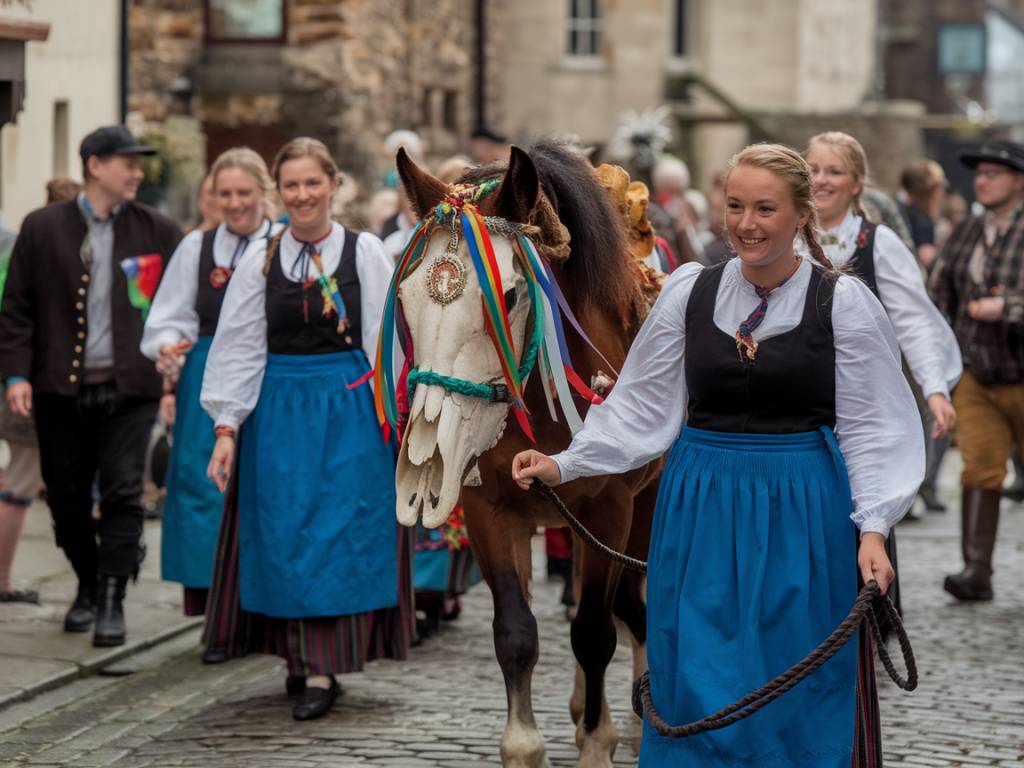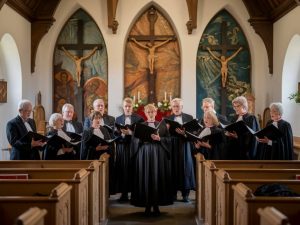The tradition of Mari Lwyd: origins and modern-day celebrations

The tradition of Mari Lwyd: origins and modern-day celebrations
Amidst the rolling hills and misty valleys of Wales, a peculiar figure draped in folklore and mystery makes its appearance each winter: Mari Lwyd. With its horse skull adorned with ribbons and bells, this centuries-old tradition bridges the gap between ancient customs and modern-day celebrations. But where does this hauntingly beautiful tradition come from? And how has it evolved over the years?
Roots of Mari Lwyd: A Pagan Past?
The origins of Mari Lwyd are as obscure as the mists that shroud the Welsh countryside. Many scholars believe that the tradition has roots in pre-Christian, pagan rituals. The name “Mari Lwyd” is often translated as “Grey Mare,” a nod to the skeletal horse figure central to the tradition. Horses, revered in Celtic mythology and spirituality, were symbols of strength, fertility, and the otherworldly.
Some theories suggest that the Mari Lwyd may have been connected to ancient midwinter celebrations. In particular, it might have symbolized the waning of the old year and the arrival of the new. The horse could have represented fertility for the coming agricultural season or served as a spiritual guide through the darkest months of winter. Whatever the exact origins, this mystical figure has survived centuries of religious and cultural shifts to remain a beloved part of Welsh heritage.
Mari Lwyd Meets Christianity
When Christianity spread across Wales, many pagan customs faced suppression. However, like many other traditions, Mari Lwyd managed to adapt and survive by taking on new forms. By the 18th and 19th centuries, the tradition had become tied to the Christmas and New Year season, often blending elements of caroling and wassailing.
The Mari Lwyd was commonly accompanied by a small group of singers and performers, known as the “party.” Together, they would visit homes in their community, exchanging verses with the residents in a playful contest called “pwnco.” If the party « won » the verbal sparring and was granted entry, it was believed to bring good luck to the household for the year ahead. Of course, Mari’s skeletal appearance added an extra layer of eerie charm to the festivities, creating a tradition both whimsical and slightly haunting.
What Does a Mari Lwyd Look Like?
If you’ve never seen a Mari Lwyd, you’re in for a visual treat. Imagine a horse’s skull, typically whitened to gleaming perfection, mounted on a pole. Its hollow eyes are often filled with glass or decorative baubles, giving it an almost lifelike gaze. Flowing white cloth drapes over the skull and the individual carrying it, creating a ghostly effect. The ensemble is further adorned with colorful ribbons, bells, and sometimes sequins.
In some cases, the jaw of the skull is mounted in such a way that it can be snapped open and closed, lending a playful (or terrifying!) element to the performance. When Mari Lwyd visits a household, it’s not unusual for the « horse » to make mischievous attempts to steal food or gifts, much to the delight of children and adults alike.
Modern-Day Celebrations: Keeping the Tradition Alive
In the mid-20th century, the tradition of Mari Lwyd saw a decline, as industrialization and urbanization pulled people away from their rural roots. However, in recent decades, this ancient custom has experienced a renaissance, thanks to local efforts to preserve Welsh culture and heritage.
Today, Mari Lwyd celebrations can be found in various communities across Wales, often as part of Christmas or New Year events. Towns like Llangynwyd, Chepstow, and Swansea host Mari Lwyd performances where locals and visitors alike can experience the magic of this tradition.
Modern Mari Lwyd processions often include:
- Music and Song: The pwnco tradition remains alive, with participants exchanging witty rhymes in Welsh or English. Traditional Welsh folk music often accompanies the performance, lending a joyous and communal atmosphere.
- Merrymaking: These days, Mari Lwyd events are often paired with festive markets, warm mulled cider, and plenty of laughter. It’s an opportunity for communities to come together during the cold, dark months of winter.
- Costumes and Creativity: While the horse skull remains traditional, many modern Mari Lwyd creators put their own artistic spin on the decorations. From glittering skulls to elaborate textiles, each Mari is a unique work of art.
What Makes Mari Lwyd So Special?
As with many folk traditions, Mari Lwyd is more than just a relic of the past. It’s a living testament to the resilience and adaptability of human culture. Despite its eerie appearance, Mari Lwyd is ultimately a celebration of joy, community, and the enduring charm of Welsh heritage.
When you stand in a crowd and watch the Mari Lwyd approach, hearing the jingle of its bells and the rhythm of its songs, you can’t help but feel connected—both to the past and to the people around you. Perhaps that’s why this ancient tradition continues to thrive in modern times. It reminds us that even in the darkest months of the year, there’s light, laughter, and a shared sense of belonging.
How Can You Experience Mari Lwyd for Yourself?
Whether you’re a Welsh local or a visitor seeking an authentic cultural experience, there are plenty of opportunities to encounter the Mari Lwyd. You’ll find many towns and villages hosting events during the festive season. Keep an eye out for announcements in local newspapers or community websites—you might just find yourself face-to-face with Mari and her mischievous party!
If you’re unable to attend an event in person, why not dive into Welsh culture at home? Explore traditional Mari Lwyd songs, create your own whimsical decorations, or even try your hand at composing pwnco rhymes. After all, what better way to honor this unique tradition than by keeping its spirit alive in your own way?
Mari Lwyd stands as a beautiful example of how ancient customs can evolve yet still retain their magic. This winter, dare to embrace the eerie, step into the festive, and let the Grey Mare bring her timeless charm into your world.





